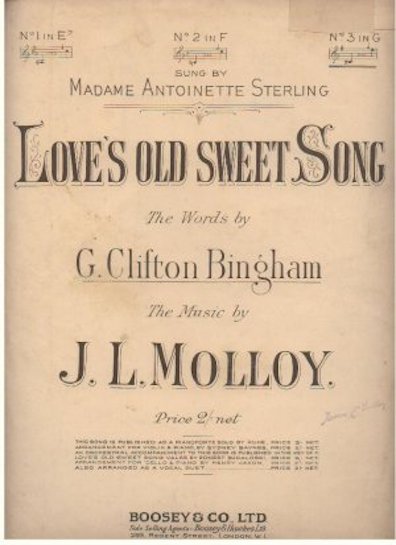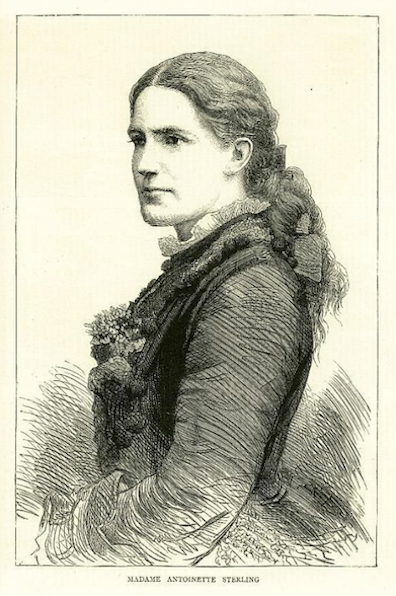Love's Old Sweet Song
Love's Old Sweet Song
In Brief
Molly tells her husband in Calypso that there will be two numbers on the "programme" for her upcoming concert tour. Mozart's lusty duet of sexual seduction will be paired with a sentimental celebration of enduring love, "Love's Old Sweet Song." An English poet, G. Clifton Bingham, wrote the lyrics of this popular Victorian song, and the Irish composer James Lynam Molloy set them to music. Published in 1884 as sheet music, the song enjoyed great popularity in home parlors as well as on the concert stage.
Read More
The song begins with low notes supporting a verbal picture of some vaguely ancient time when "mists began to fall" on the world, but even as it mentions the mists the musical line is rising in pitch. With "dreams that rose in happy throng," the music reaches a fourth above the beginning tonic ("dreams"), and then a fifth ("throng"). The feeling of happy confidence expressed in this rise continues into the beautiful melody of the chorus, where the fifth is attained twice more at "twilight" and "weary," and then surpassed by a soaring sixth on the second iteration of "twilight." The fifth returns once more at "old song," and the final line of the song reaches up to a climactic octave.
- Once in the dear dead days beyond recall,
When on the world the mists began to fall,
Out of the dreams that rose in happy throng,
Low to our hearts Love sang an old sweet song;
And in the dusk where fell the firelight gleam
Softly it wove itself into our dream.
(Chorus)
Just a song at twilight, when the lights are low,
And the flick'ring shadows softly come and go;
Though the heart be weary, sad the day and long,
Still to us at twilight comes Love's old song,
Comes Love's old sweet song.
Even today we hear Love's song of yore,
Deep in our heart it dwells forevermore;
Footsteps may falter, weary grow the way,
Still we can hear it at the close of day;
So till the end, when life's dim shadows fall,
Love will be found the sweetest song of all.
(Chorus)
Zack Bowen argues that this song "tends to reenforce the image of the Boylan-Molly intimacy and is destined also to recur many times through the rest of the book, each time with the overtones of Molly's promiscuity" (Musical Allusions in the Works of James Joyce, 87). It is hard to imagine how he could think this. With its appeal to a past so distant that it can barely be remembered, its evocation of a dream that survives deep in the heart, its mention of a long sad day that leaves the traveler weary, and its tender promise that Love will ultimately "be found the sweetest song of all," Bingham's text seems tailor-made to suggest that an enduring love in the Blooms' relationship may overcome the transient flash of sexual excitement that Molly experiences with Boylan.
The texts and emotional registers of Là ci darem and Love's Old Sweet Song could not be more different. Bowen is certainly right, though, about their pairing and their pervasive presence in the novel (nine and twelve mentions, respectively). One cannot adequately read Ulysses without having the tunes of many songs run through one's brain whenever they appear in the text. These two in particular are so central that they could be called the theme songs of Ulysses. Their interplay initiates and sustains an uncertainty about the outcome of Molly's affair that carries into her monologue in Penelope.
When Bloom returns home in Ithaca, the piano in his parlor has a copy of Love's Old Sweet Song on the musicrest. Its title page lists not only the composer, the lyricist, and the key, but also "Madam Antoinette Sterling," an American contralto with a big, rich voice. Sterling gave many concerts in England in the 1870s and 80s, moving in her later years from oratorios and lieder to sentimental ballads like Molloy's. She was immensely popular.
In Penelope Molly hears a long train whistle whose
"frseeeeeeeefronnnng" makes her think of "the end of
Loves old sweeeetsonnnng." She is thinking of the
last two syllables of the chorus: "sweet," given two simple
eighth notes in the score, often lends itself to melismatic
elaboration, and "song" occupies the space of a whole note.
Later she hears the train again and thinks of the song in more
detail: "Frseeeeeeeeeeeeeeeeeeeefrong that train again weeping
tone once in the dear deaead days beyond recall close
my eyes breath my lips forward kiss sad look eyes open piano
ere oer the world the mists began I hate that istsbeg comes
loves sweet sooooooooooong Ill let that out full
when I get in front of the footlights again."And shortly
afterward she thinks of the song a third time: "comes
looooves old deep down chin back not too much make it double."
In these latter two passages Molly thinks about how she will
perform the piece: the emotion she can communicate about "days
beyond recall" with her eyes and her lips, the piano dynamics
she must maintain through the phrase "ere o'er the world," the
deep vowel sounds she can produce in "love's old" by keeping
her chin back, the "weeping tone" she can get by doubling the
single syllable of "dead" into "deaead" over the course
of a quarter note, the difficulty of articulating all the
clustered consonants of "mists began" ("istsbeg"), the
extended whole note of the final "song" (in the 3/4 time
signature of the sheet music, a dotted half note tied to a
quarter note with a fermata). Molly is an artist. Elsewhere
she thinks of aesthetic choices that two male singers have
made in performing another
popular song of the 19th century, approving of Simon
Dedalus' natural articulation and scorning Bartell Darcy's
pompous artificiality.
§ The first edition in 1922 contained what would seem to be one more literary imitation of musical effects: "days beyond recall" was printed as "days beyondre call." This typography was corrected in the Odyssey Press editions, but the Gabler edition restores it. Tempting as it is to find one more inventive deployment of language in the passage, my online text assumes that the editors of the 1930s knew what they were doing, because the short "re" seems to belong as firmly to its "call" as "be" does to its "yond." The song gives these two words a very natural musical expression, converting the iambs (be-YOND re-CALL) into a simple dotted rhythm (short-LONG short-LONG). If there is anything in the music corresponding to "beyondre," I cannot hear it.

